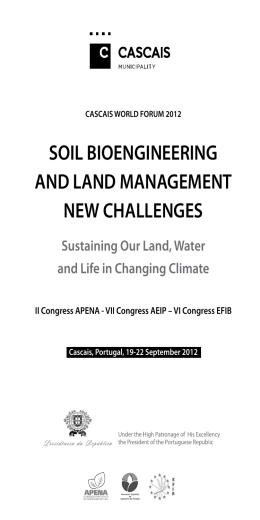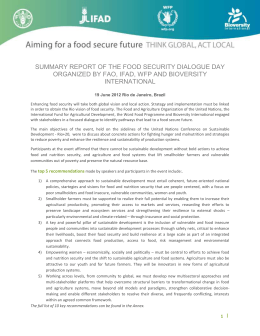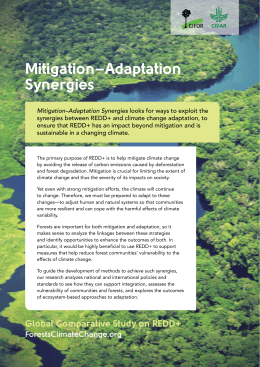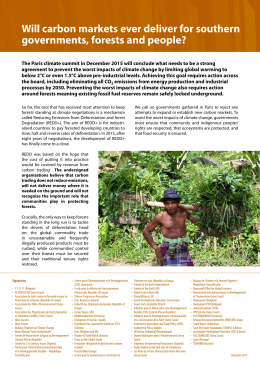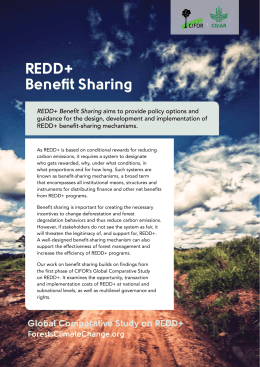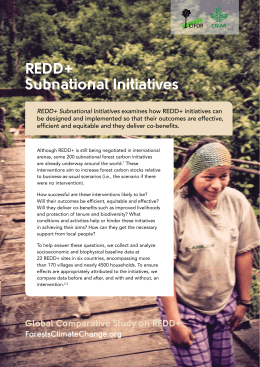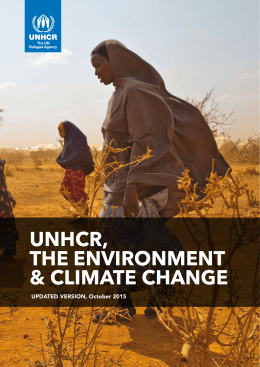Global Landscapes Forum recommendations for UNFCCC and SDGs: full key messages See the executive summary at: www.landscapes.org/executive-summary-key-messages-global-landscapes-forum 1. How can the landscapes approach contribute to the UNFCCC process? Agriculture Nothing has happened in the UNFCCC process on agriculture since Durban 2009. By complete inaction the UNFCCC makes itself irrelevant. So it is recommended that UNFCCC gets back on track on agricultural negotiations if it does not want to lose completely lose its credibility and let down the people of the world, not least farmers, who already suffer the most and contribute the least to the looming climate catastrophe. The world has technologies, systems and practices to move ahead but it needs a UNFCCC frame stimulate action and investments, not least on adaptation for which funding is currently marginal and negligible compared to mitigation. — From CCAFS, CTA, Sub-Plenary 3: Synergies between adapting to and mitigating climate change in forest and agricultural landscapes [The UNFCCC should] urge negotiators to consider smallholder interests. We need to ensure that a fair share of climate finance goes to smallholders to prevent elite capture. By integrating agriculture, trees and forests, a landscape approach produces multiple benefits that should be promoted in the UNFCCC process rather than ignored. — From World Bank, Discussion Forum 7: Farm and smallholder opportunities: Synergies and opportunities for integrating agriculture, trees and forests Ecosystems Landscape approaches that restore and strengthen ecosystem services will contribute to resilient land and livelihoods providing adaptation and mitigation benefits. Importance of building up soil organic matter by increasing vegetation especially with functional biodiversity that provides ecosystems services and this will increase productivity at every level that includes plant crops and animals in the system. Getting as much biomass and biodiveristy in the system (below and above ground) — the greater the biodiversity in systems the greater the resilience. Sustainable land use — restoring degraded systems and maximizing their ecological services potential provides more feed for livestock and more organic matter for soil fertility, productivity and drought resilience and soil stability against wind erosion e.g. through organic agriculture. — From IFOAM, Research Institute of Organic Agriculture (FiBL), Biovision, Millennium Institute, Discussion Forum 11: Resilient land and livelihoods: Organic practices and enabling policies for food security and people-centered rural development landscapes.org 1 Taking an integrated approach, across landscapes, would enable policy-makers to formulate and implement policies that turn carbon benefits into co-benefits. For example, policies to restore forests and landscapes would sequester carbon and enhance adaptive capacity, while being motivated primarily by food security, water, biodiversity and socio-economic considerations. — From CBD, Discussion Forum 1: Ecosystem conservation and restoration for healthy and productive landscapes Diversity at landscape level — of landscape elements, species and genetic resources, resource management practices and livelihood options — enhance ecosystem and human resilience. Policies, institutional support, research and resource management should seek to maintain and enhance diversity and avoid simplification. Reflecting this approach in formulation and implementation of countries' National Adaptation Plans would enhance long term adaptation. — From FAO, Sub-Plenary 4: Building resilient landscapes for food security and sustainable livelihoods Forestry Reduced deforestation and improved social outcomes require sustainable commodity supply chains, which can best be achieved by a commitment to strategic coordination between actors and interventions; design mitigation and adaptation strategies through a landscape lens. — From International Forestry Resources and Institutions (U Michigan), The Forests Dialogue, Technical Session 1.6: Managing landscapes for food, fuel, fiber and forests: innovative approaches in a time of food insecurity and climate change Changes in land use are often viewed negatively from a climate point of view. The main reasons for that is that landscape planning is split between sectors and often driven by short-term needs without sustainability perspective. Forest extension, and the development of holistic national forestry programs is one of the most rational solutions for the next decades to mitigate climate change taking into account social dimensions. — From Ministry of Environment of Poland, Technical Session 1.8: Exploring the potential of National Forest Programmes in support of integrated approach to SFM and landscape solutions in tackling climate change challenges Youth In developing sustainable solutions to tackle climate change issues, the UNFCCC must engage with and listen to the voice of youth in the landscape sector who contribute much needed innovative ideas and energy. Capacity development of youth movements within these processes is critical for them to contribute to their future. — From YPARD, Youth Session landscapes.org 2 Policy and REDD+ Policymakers should provide incentives and enforceable legal frameworks that support local and regional level actors to work across jurisdictions and sectors, and coordinate upwards and downwards to enable effective landscape governance systems and achieve multiple benefits and climate resilience from landscapes where agriculture is an important land use. — From LPFN, EcoAgriculture Partners, Technical Session 1.3: Exploring Governance Strategies for Integrated Landscape Management [The UNFCCC should] provide an integrated way of approaching mitigation that captures all the related co-benefits for on the ground actions — From CCAFS, CLUA, WFO, Discussion Forum 2: Rolling up our sleeves on agricultural mitigation for landscape benefits Development of MRV and benefit-sharing systems are inter-dependent and both are getting off the ground, albeit slowly. • Policy makers are acting on data that are produced and published. • Missing institutions are the main challenge to implement the landscapes approach. • Is missing data or political resistance causing the lack of performance-based payments? — From CIFOR, Discussion Forum 3: REDD+ Performance at the landscape level Many climate-related policies would benefit from encompassing the potential joint impact of multiple sectors. Models should be used to simulate and map many different potential future impacts e.g. biodiversity loss, transportation costs of commodities, change in land cover that should be integrated into land use planning and REDD+ policies. — From UNEP-WCMC, Technical Session 1.1: Supporting landscape-scale planning for REDD+: How useful are land-use change models? Recognize and prioritize the rights, needs and role of rights holders like indigenous peoples, peasants, pastoralists and women and their indigenous territories and community conserved areas (ICCAs). These groups often carry the main burden of trade-offs and offset approaches like ‘land degradation neutral’ policies and REDD+. Additionally, address the underlying causes of forest loss, including unsustainable livestock production and consumption, which cannot be addressed through REDD+ and individual projects. — From Global Forest Coalition, Technical Session 2.2 on Land, landscapes, livestock and farms Changes in the natural environment are caused to large extent by direct human intervention in the environment. Developing a shared understanding that land use and land-use change reliant on a combination of agriculture, water and forestry is a landscapes.org 3 necessity. Taken separately, they do not guarantee a holistic understanding of the challenges, or the possibility of effective action. — From Warsaw University of Life Sciences, Technical Session 2.9: Landscapes – a holistic approach to forests, water and agriculture systems in the context of climate change Working through landscapes, the relationship between land, food, climate and human security is addressed and evidence built for NAP and NAMA formulation and finance to inform the UNFCCC process. — From FAO, IFAD, CTA, Discussion Forum 8: Sustainable Landscapes, food security and adapting to climate change Synergy is complex and therefore requires going beyond climate smart agriculture to a landscape level as well as policy levels. If well done, it can bring both effectiveness and efficiency gains. Metrics for synergy as well as methodology and tools are needed to guide policy and decision-making processes. — From ICRAF, Discussion Forum 5: Landscape approaches at the nexus of climate change mitigation and adaptation: Synergies and trade-offs National Adaptation Plan (NAP) development can contribute to climate smart agriculture by facilitating cross-sector planning between the agriculture, forestry, water and energy sectors. The nexus between these sectors is strengthened when NAPs are integrated in to existing development and sector policies, efforts are made to fund NAPs sustainably through domestic budgets, and sufficient stakeholder engagement is undertaken early and often, particularly engagement with the private sector. — From CIAT, ILRO, Kenyan Ministry of the Environment, Discussion Forum 12: National Adaptation Plans: Opportunities for cross-sevtor synergies in the nexus between water, food security, forests and energy? Landscape approaches require governance and legal frameworks to cross levels and sectors, informed by the best possible science of the problem. A policy learning architecture is needed to assess how interests and imperatives are prioritized and how collaborative solutions can be found. — From IUFRO, IDLO, CIFOR, Discussion Forum 10: Governance and legal frameworks for sustainable landscapes Mountains A landscapes approach that includes mountains can be fed into the UNFCCC process and raise awareness about the vulnerability of mountain ecosystems to climate change, the melting of glaciers and the impact on water resources worldwide, about the available indigenous solutions and about the need for policies that promote resilience and adaptation in mountain areas. — From Mountain Partnership, Technical Session 2.10: Recommendations from the technical & networking session: building climate change resilience in mountains landscapes.org 4 Water The landscape approach is a long-term proven approach through watershed management/territorial development to improve the adaptive capacity and resilience of rural communities and secure food security. Negotiators in the UNFCCC must recognize that such large-scale interventions generating multiple livelihoods, food security and global environment benefits need reliable long-term and multi-sector support and funding mechanisms beyond conventional project approaches. Watershed management is a nested multi-scale, multi-stakeholder and multi-sector approach within the overarching landscape concept. — From Global Donor Platform, Technical Session 2.5, Towards a sustainable landscape approach: New generation of integrated watershed management Investment and finance Sustainable rural landscapes are an environmentally sound and low cost option for mitigating and adapting to climate change. In particular investing in adaptation in rural landscapes is a no-regrets pathway to mitigation. There's a role for everybody: both public and private sectors in this area. Businesses are increasingly committed to sustainable supply chains. The challenge is to put in place policy that creates good governance, attracts long-term responsible private investment within a stable tenure environment. — From World Bank, Sub-Plenary 1: Investing in sustainable landscapes in forests and on farms Gender The UNFCCC process has to focus on and enable more knowledge and technology transfer on the ground, especially in the farming sector and in REDD. Projects on landscapes management contribute to mitigating and adapting to climate change. These projects also contribute to transforming unequal relationships between men and women. The reasoning behind this is simple: Women, especially women farmers, are key to increasing food security and ensuring a sustainable management of natural resources. — From WFO, IUFRO, CIFOR, FANRPAN, Discussion Forum 4: Linking gendered knowledge with gender-responsive action in the landscape: what works? landscapes.org 5 2. Why is a landscapes approach important for the design of the Sustainable Development Goals? Landscapes approach The landscape approach – which takes a holistic view of a broad range of land use and interactions between human activities and environmental response should be an effective tool for sustainable development and furthering debates on climate change policy. — From Warsaw University of Life Sciences, Technical Session 2.9: Landscapes – a holistic approach to forests, water and agriculture systems in the context of climate change Landscape approaches provide the ideal framework for the development of landrelated sustainable interventions, such as [reconciling] food security, timber supply and ecological conservation for the provision of ecosystem services. — From International Institute for Sustainability, Technical Session 2.3: Landscape approach to reforestation of the Atlantic Rainforest, Brazil: Socio-environmental context and economic viability The landscape approach addresses development across scale ranging from farm to watershed and land-use systems, thus showing viable solutions to the realization of SDG. — From FAO, IFAD, CTA, Discussion Forum 8: Sustainable Landscapes, food security and adapting to climate change South-South learning regarding National Adaptation Plan (NAP) development is needed for countries to share success stories and lessons learned regarding cross-sector planning in the agriculture, forestry, water and energy sectors within the NAP process. — From CIAT, ILRO, Kenyan Ministry of the Environment, Discussion Forum 12: National Adaptation Plans: Opportunities for cross-sector synergies in the nexus between water, food security, forests and energy? Building a comprehensive SDGs framework should include an integrated landscape perspective. This would enable and compel the development of mutually supportive goals, while breaking down institutional silos. A landscape-based indicator would provide an integrated and coherent picture, thereby measuring the performance of future SDGs. — From CBD, Discussion Forum 1: Ecosystem conservation and restoration for healthy and productive landscapes Governance Well-functioning human landscapes is an ultimate objective that can underpin sustainable development and SDGs. Effective local ownership, control and governance are essential for maximizing contributions of landscapes to food security and human well-being. Countries should strengthen and empower local institutions, including landscapes.org 6 farmer and forestry organizations, and support governance mechanisms that enable local people’s active role in resource planning and decision making and avoid inequities in gender or resource endowment. — From FAO, Sub-Plenary 4:Building resilient landscapes for food security and sustainable livelihoods Co-designing viable landscape governance systems that support a holistic framework and the needed institutional arrangements and decision-making processes for integrated planning and management across sectors, jurisdictions and multiple levels of government that will address the full range of needs, environmental, social and economic from the rural land base. — From LPFN, EcoAgriculture Partners, Technical Session 1.3: Exploring Governance Strategies for Integrated Landscape Management Innovative interventions are required to achieve sustainability in the diverse SDG priorities. Landscape approaches can help develop a collective undertaking. For holistic solutions, we should learn from policies, laws and instruments used by multiple levels, public and private sectors, and scientific knowledge. A coherent design of SDGs can facilitate durable solutions on the ground. — From IUFRO, IDLO, CIFOR, Discussion Forum 10: Governance and legal frameworks for sustainable landscapes Stakeholders and equity The SDGs should support rights-based, socially just, effective, and holistic policies to address the drivers of forest loss and ecosystem degradation, including demand-side drivers. They should also recognize and prioritize the rights, needs and positive contribution to ecosystem conservation of marginalized groups like Indigenous peoples, local communities, pastoralists and peasants. — From Global Forest Coalition, Technical Session 2.2: Land, landscapes, livestock and farms Landscapes approaches enable communities and other stakeholders to manage the natural resources and ecosystems at scale and in the long term so as to generate sustainable food and agriculture, socio-economic and environmental benefits at local and national levels as well as contributing to the global goals of the Rio convention (biodiversity, climate change, combating land degradation). — From Global Donor Platform, Technical Session 2.5: Towards a sustainable landscape approach: New generation of integrated watershed management Information and research Integrated and spatially explicit landscape modeling approaches provide crucial local, regional and global scientific evidence to assess and support the design of climate change policies. Appropriate, socially and environmentally sound policies, which have landscapes.org 7 wide stakeholder acceptance, will support and contribute to achieving sustainable development goals. — From UNEP-WCMC, Technical Session 1.1: Supporting landscape-scale planning for REDD+: How useful are land-use change models? Science-based evidence related to agriculture and food security scenarios, in the context of climate change, is critical in guiding current and future climate change negotiations, as well as for the sound design of the SDGs. Scenario building, inclusive of crop modeling and economic modeling forecasts, should be considered in an interdisciplinary approach. Landscapes approach provides a new way for a more inclusive forecasting. We simply can't just think about climate, agriculture and food security, without thinking also about technology and social impacts and changes, population trends, economical changes, and politics. — From WLE, Technical Session 1.4: Rethinking investments in sustainable landscapes and livelihoods Achievement of enhanced sustainability goals requires transparency, effective monitoring, and evidence-based impact assessment of commodity supply chain interventions, as well as multi-stakeholder cross-sectoral partnerships. Moreover landscape approaches and the focus on sustainability is a better guarantee of the survival of the landscape in the long term than individual land use sector strategies. Through expansion of a trans-national model forest network we can support sustainable development goals and their achievements. — From International Forestry Resources and Institutions (U Michigan), The Forests Dialogue, Technical Session 1.6: Managing landscapes for food, fuel, fiber and forests: innovative approaches in a time of food insecurity and climate change Gender Session recommendations included ensuring that women are fully represented in this process as they make up the majority of smallholder farmers in developing countries; that approaches to certification are streamlined so that multiple certification visits do not need to be made to small, rural communities; and that there be proper assessment of the demand side for broader environmental services credits to ensure that they are viable on a market. — From The Gold Standard, Forest Stewardship Council and Fairtrade International, Technical Session 1.7, Certifying Eco-System Services in Forestry and Agriculture: Ensuring Genuine MRV and Social & Environmental Integrity at a Landscape Level Mountains In a world struggling with scarcer resources, growing population and the consequences of climate change, a landscapes approach that includes mountains can contribute to a landscapes.org 8 sustainable world as mountains provide products and services - such as water, food and energy - essential to mountain communities and to the world at large. — From Mountain Partnership, Technical Session 2.10: Recommendations from the technical & networking session: building climate change resilience in mountains Agriculture Healthy and resilient landscapes are key to achieve and secure food security and nutrition as well as poverty eradication. People-centered landscape approaches ensuring sustainable management of natural resources can achieve multiple goals: environmental, economic and social. Include organic agriculture as one indicator of the uptake of sustainable agriculture and food systems that provide nutrition, additional jobs and ecosystem services and poverty alleviation. — From IFOAM, Research Institute of Organic Agriculture (FiBL), Biovision, Millennium Institute, Discussion Forum 11: Resilient land and livelihoods: Organic practices and enabling policies for food security and people-centered rural development A landscapes approach would provide a platform to accurately portray the relative contribution of agricultural mitigation actions on food security, climate adaptation and sustainable development. — From CCAFS, CLUA, WFO, Discussion Forum 2: Rolling up our sleeves on agricultural mitigation for landscape benefits Investment The landscape approach, REDD+ and the Green Economy are converging around the need for food security, poverty eradication and climate action. REDD+ can be a catalyst for a new economic paradigm to invest in natural and social capital. A new investment asset class focusing on sustainable landscapes is emerging, but to successfully scale up, long-term enabling conditions are required. An SDG focusing on sustainable landscapes could unlock private sector innovation and investment, turning trade-offs into synergies. — From UNEP, EcoAgriculture Partners, Discussion Forum 6: Landscapes in a Green Economy landscapes.org 9
Download
